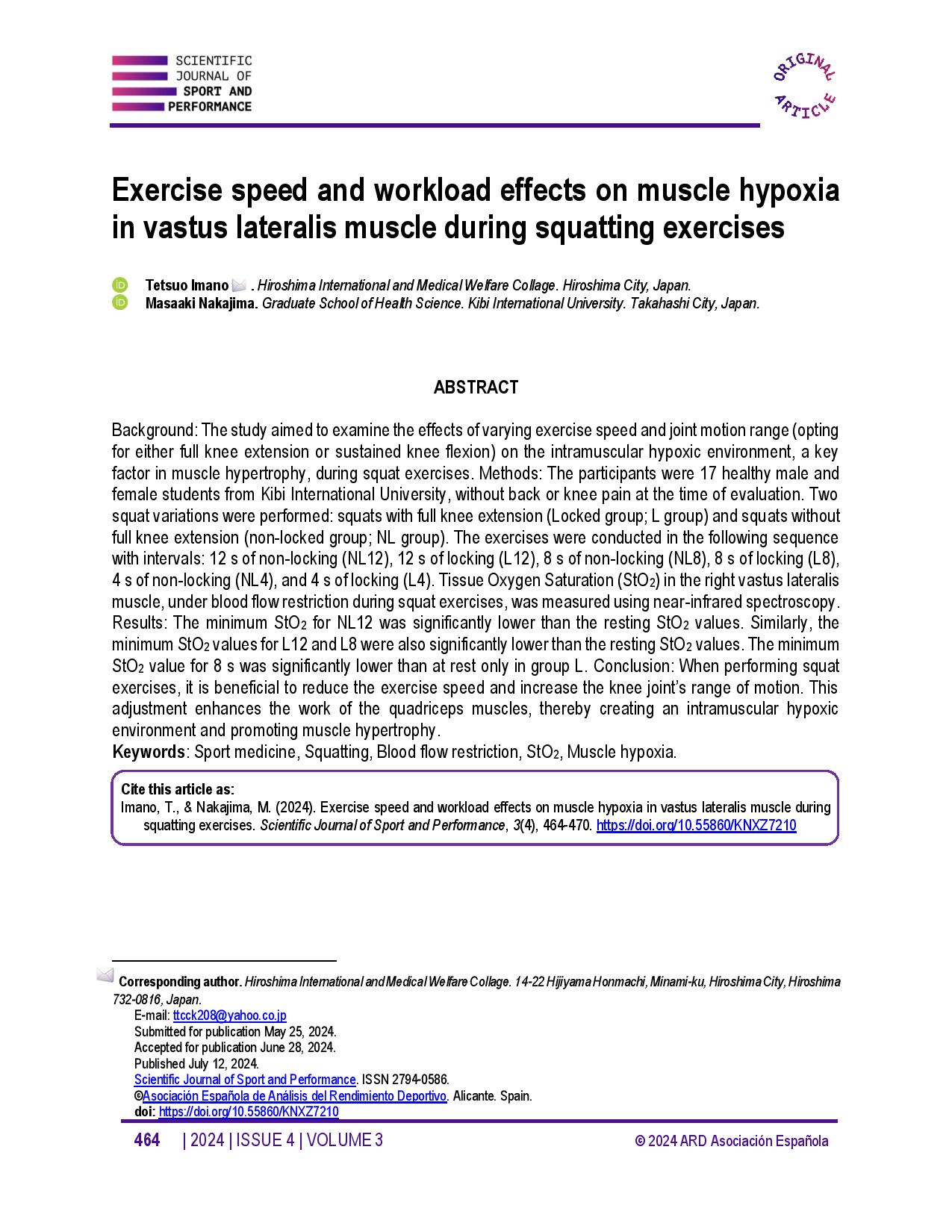Exercise speed and workload effects on muscle hypoxia in vastus lateralis muscle during squatting exercises
Main Article Content
Abstract
Background: The study aimed to examine the effects of varying exercise speed and joint motion range (opting for either full knee extension or sustained knee flexion) on the intramuscular hypoxic environment, a key factor in muscle hypertrophy, during squat exercises. Methods: The participants were 17 healthy male and female students from Kibi International University, without back or knee pain at the time of evaluation. Two squat variations were performed: squats with full knee extension (Locked group; L group) and squats without full knee extension (non-locked group; NL group). The exercises were conducted in the following sequence with intervals: 12 s of non-locking (NL12), 12 s of locking (L12), 8 s of non-locking (NL8), 8 s of locking (L8), 4 s of non-locking (NL4), and 4 s of locking (L4). Tissue Oxygen Saturation (StO2) in the right vastus lateralis muscle, under blood flow restriction during squat exercises, was measured using near-infrared spectroscopy. Results: The minimum StO2 for NL12 was significantly lower than the resting StO2 values. Similarly, the minimum StO2 values for L12 and L8 were also significantly lower than the resting StO2 values. The minimum StO2 value for 8 s was significantly lower than at rest only in group L. Conclusion: When performing squat exercises, it is beneficial to reduce the exercise speed and increase the knee joint’s range of motion. This adjustment enhances the work of the quadriceps muscles, thereby creating an intramuscular hypoxic environment and promoting muscle hypertrophy.
Article Details

This work is licensed under a Creative Commons Attribution-NonCommercial-ShareAlike 4.0 International License.
References
Anderson J.E. (2000). A role for nitric oxide in muscle repair: nitric oxide-mediated activation of muscle satellite cells. Mol Biol Cell, 11: 1859 -1874. https://doi.org/10.1091/mbc.11.5.1859 DOI: https://doi.org/10.1091/mbc.11.5.1859
Bonde-Petersen F., Mork A.L., and Nielsen E. (1975). Local muscle blood flow and sustained contractions of human arm and back muscles. Eur J Appl Physiol, 34: 43-50. https://doi.org/10.1007/BF00999914 DOI: https://doi.org/10.1007/BF00999914
Ezaki O. Mechanisms for Anti-sarcopenic Effectsin Endurance Exercise and Resistance Training (in japanese). Gakuen, Tokyo 2012,866:1-13. Retrieved from [Accessed 2024, June 02]: https://swu.repo.nii.ac.jp
Ishida Y., Kojima Y.,Hiroaki K.,Tsunoda N.,Matsuo A.,Fukunaga T. (1986). Relationships between the thickness of subcutaneous fat and physical fitness test scores in female students (in japanese). Jpn J Phys Fitness Sports Med, 35(6), 499. https://doi.org/10.7600/jspfsm1949.35.297 DOI: https://doi.org/10.7600/jspfsm1949.35.297
Kimura N., Hamaoka T., Kurosawa Y., Katsumura T. (2006). Contribution of Intramuscular Oxidative Metabolism to Total ATP Production during Forearm Isometric Exercise at Varying Intensities. Tohoku J. Exp. Med, 208:307-320. https://doi.org/10.1620/tjem.208.307 DOI: https://doi.org/10.1620/tjem.208.307
Korthius R.J., Granger D.N., Townsley M.I., and Taylor A.E. (1985). The role of oxygen derived free radicals in ischaemia-induced increases in skeletal muscle vascular permeability. Circ Res, 57: 599 – 609. https://doi.org/10.1161/01.RES.57.4.599 DOI: https://doi.org/10.1161/01.RES.57.4.599
Koba S., Hayashi N., Miura A., Endo M., Fukuba Y., and Yoshida T. (2004). Pressor response to static and dynamic knee extensions at equivalent workload in humans. Jpn J Physiol, 54: 471-481. https://doi.org/10.2170/jjphysiol.54.471 DOI: https://doi.org/10.2170/jjphysiol.54.471
Tanimoto M., and Ishii N. (2006). Effects of low-intensity resistance exercise with slow movement and tonic force generation on muscular function in young men. J Appl Physiol, 100: 1150-1157. https://doi.org/10.1152/japplphysiol.00741.2005 DOI: https://doi.org/10.1152/japplphysiol.00741.2005
Tanimoto M., and Ishii N. (2009). Slow Training Diet the Complete Edition (in Japanese). Tokyo:Takahashi shoten.
Nakamura K.,Ogata T. (2016). Locomotive Syndrome: Definition and Management. Clinic Rev Bone Miner Metab, 14:56-67. https://doi.org/10.1007/s12018-016-9208-2 DOI: https://doi.org/10.1007/s12018-016-9208-2
Neuman D. A. (2009). Kinesiology of the Musculoskeletal System: Foundations for Rehabilitation.2nd edition.St.Louis:Mosby.
Takemiya T., Higuchi Y., Nagashima C. (1973). On the time course of exercise hyperemia and hematocrit variations in rabbit hindlimb. Jpn J Phys Fitness Sports Med (in Japanese), 22:85-93. https://doi.org/10.7600/jspfsm1949.22.85 DOI: https://doi.org/10.7600/jspfsm1949.22.85




